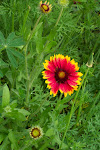Have you ever wondered what Monax is? Or Platonite? Or why some glass is white but isn’t called milk glass? Many companies had their own names for white opaque glass and each company varied in how white was white and how opaque was opaque. Not all white glass is milk glass and we’ll show you the different terms.
Fenton was one of the milk glass champions, especially with their Hobnail and crests. Fenton made Hobnail in white glass and colors, and during the mid 1970s one could buy over 200 different pieces in Hobnail white milk glass. You can find a huge number of shapes, including dinnerware, decorative pieces such as vases, even a wall-mounted water tap and basin, called a lavabo. Fenton’s Hobnail is solid, opaque white and is typical of what most people have in mind when they think of milk glass. The photo shows a small basket in Fenton's Hobnail.
Fenton made white glass with various colored, transparent edges in fanciful shapes. These are called crests, and the best known is the white glass with crystal rim, called Silver Crest. Fenton varied the formula over time and the white in their crests ranges from almost opalescent to a chalk white. One can use this to date Silver Crest. The cornucopia candleholder in the picture has a hint of creamy opalescence and dates to the late 1940s or early 1950s. Silver Crest with a whiter glass was made after 1958. You can find Silver Crest with hand painted designs and most of these are more recent. The other photo is Peach Crest, which is white glass over ruby with a crystal edging.
MacBeth Evans, who made American Sweetheart and Petalware, among other patterns, used a thin white glass that in its early years often had a tinge of opalescence. This was Monax depression glass, which was meant to be white. MacBeth Evans also made Cremax or Ivrene which was creamier and more beige. The photo shows a Cremax / Ivrene Petalware cream soup.
MacBeth Evans produced glass patterns in the 1940s and 50s that are less well-known than their depression patterns. These patterns, including Oxford and Classic, have intricate borders with otherwise simple designs. We show several examples of this on our website. The MacBeth Evans glass made after the depression is attractive and sturdy enough to be usable with your family. It may be a good place for you to start a new collection. Eventually Corning Glass bought MacBeth Evans. You can see the influence of the Monax on the later Pyrex dinnerware and Corelle line. The picture below left is the Classic pattern which has an intricate scroll pattern around the rim. This comes with decorations and decals. The other is the Oxford pattern which has a different rim treatment. The Oxford pieces we've seen have been whiter than the Classic or Cremax glass.
Anchor Hocking used white glass for several lines, incuding the well-known Fire King staples such as Wheat or the Gay Fad-decorated cookware. This is white but not as opaque or as heavy as you may expect from milk glass. If you find a shiny white glass that is somewhat translucent with a surface design of grapes on a stippled background it may be Vintage, made in the 1970s. It came in accent pieces such as planters, vases and candy dishes and a snack set. Anchor Hocking used the same glass for their Hobnail pattern.
Hocking made a wonderful array of kitchen items such as bowls or spice jars in Vitrock white glass. This is opaque, solid white. During the later part of the depression Hocking used this in a small dinnerware set that is known as Vitrock or Flower Rim. The cup and saucer are shown. You can see the difference between this and the later, more tranlucent white used in Vintage or Hobnail.
Westmoreland was another milk glass maven. Their milk glass is solid white, often times hand painted with fruit or birds or flowers. Patterns include Paneled Grape, which has an intricate molded pattern of grapes and leaves, and Beaded Edge, which has a rim of small beads. Westmoreland was also known for their animal and hen dishes. These were animal figures on a nest or on a box. Westmoreland made some beautifully colored transparent glass, but if you do a search on eBay you may find more milk glass than anything else.
Hazel Atlas called much of their white glass Platonite. Other names included Opal, Whiteware and Milkwhite. They sold mostly decorated platonite, including pieces that were an all-over color as well as those with various designs. They made other white glass besides Platonite, and like many companies their white glass changed over time, changing thicknesses and opacity. Most Hazel Atlas platonite is rather thin glass and it doesn’t feel as heavy or solid as a lot of milk glass. The sugar shown is is Siera Sunrise Ovide which is white on the interior.
Indiana Glass made several patterns in the 1950s to 70s that you will find frequently in thrift shops or garage sales. Two examples are Harvest and Teardrop. Indiana’s Harvest is a grape pattern and you may see it listed as Indiana Grape. The pattern is a lower relief than Paneled Grape or Hocking’s Vintage. Teardrop looks like its name, with oval drip-like shapes. Indiana’s milk glass was a solid dark, chalky white, sometimes with a tinge of gray.
Whether you like the solid white glass from Westmoreland, or the thinner translucent depression ware from MacBeth Evans, you can find a wide range of styles and decorations on white glass. Even if it is called Platonite, Monax, Creamax or milk glass you will enjoy it!
3 weeks ago























2 comments:
I love learning from you, Oh Queen of Milk Glass!!! Very interesting article. Thanks for sharing! :D Jewel
Thanks for sharing this wonderful milk glass article with us.
Post a Comment